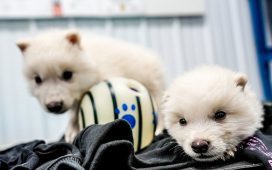A fossilized jaw bone has pushed the evolutionary timeline of mammals by a jaw-dropping 17 million years, say scientists.
The animal classification that would eventually spawn the human race was believed to have started 210 million years ago, with shrew-size creatures called morganucodontids that lived in the shadows of the dinosaurs.
However, a new study of 225-million-year-old fossils found in present-day Brazil pushes back the dawn of mammalian evolution by millions of years.
Scientists say the fossilized bone appears to represent the oldest example of a type of jaw joint that is unique to mammals.
The skeletal remains reveal that structures may have evolved approximately 17 million years earlier than was thought in unrelated mammal species that are not closely related.
University of Chicago palaeontologist Zhe-Xi Luo co-authored the study. Zhe-Xi told Popular Science that the mammalian jaw hinge is unique because the tooth-bearing dentary bone is directly connected to the jaw hinge.
This enables mammals o create more force from chewing and biting than other vertebrates with jaws.
Modern mammals evolved from within a group of animals called Cynodonts. These had a jaw joint consisting of two separate bones – the quadrate of the skull and the articular in the lower jaw and the quadrate in the skull.
Paleontologists previously believed that all mammal sister groups has similar characteristics, but the fossils hadn’t been reexamined using micro-computed-tomography (CT) scans.
Now, in the new study published in nature, the scientists used these techniques to examine 225-million-year-old fossils of two extinct cynodont species from present-day Brazil.
Study co-author James Rawson, a palaeontologist from the University of Bristol, told Popular Science the “amazing” fossils date back to the Triassic era. This was a period when animal groups like mammals, dinosaurs, crocodilians, turtles, lizards were first evolving, explained Rawson.
He said this makes the fossils “really important for understanding the origin of those groups and modern ecosystems in general”. He added: “The quality of the fossils is also incredible, many are preserved intact and also in 3D!”
The two cynodont species studied – Brasilodon quadrangularis and Riograndia guaibensis – were burrowing creatures that were less than a foot long. They spent much of their time underground, hiding from predators, similar to some small mammals that still exist today.
Brasilodon’s teeth suggest probably fed on insects and other small animals. However, Riograndia’s teeth would suggest it probably ate more plant material.
Rawson said both “really stand out” because they are are “very closely related to mammaliaforms” – an animal group that includes modern mammals and their ancestors. “Their lifestyle and anatomy gives us valuable clues into how mammals evolved their most defining features,” added Rawson.
CT scans were used to reconstruct the jaw bones. The study found Riograndia’s joint evolved entirely separately and around 17 million years earlier.
Zhe-Xi said: “Humans are mammals. We chew and bite to eat.
“Isn’t it interesting to reflect on our history: our jaw hinge that made us the mammals unique among vertebrates actually started out some 225 million years, during the time when mammals and their relatives lived in the dark Age of Dinosaurs.”








